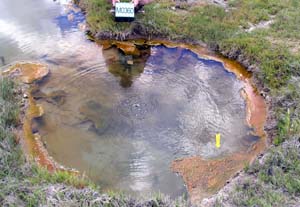MICROBIAL DIVERSITY: |
|||||||||||||||||||||||||||||||||||||||||||||||||||||||||||||||||||||||||||||||||||||||||||||||||||||||||||||||||||||
Principal Investigator: Tim Magnuson (ISU)
Bacterial communities in several of the geothermal springs in the Alvord Basin have been assessed by LH-PCR and 16S rDNA clone library techniques. Clone library and phylogenetic analyses indicate that the hot springs are dominated by an abundance of uncultured species. A sampling of the data is shown in Tables 1 and 2, which summarize the bacterial communities of the microbial mats within Mickey Hot Springs M0290 and M0360. Only a handful of previously cultured groups are represented in these libraries, including Deinococcus, Thermus, Cyanobacteria and Thermocrinis. Of particular interest are clones from the uncultured bacterial divisions OP10 and OP11. There are also clones from a deep branching clade (Table 2), which is only 84% similar to any sequence in GenBank and may represent a previously unknown bacterial division. Among the sequences obtained most display a highest sequence similarity to clones from other thermal environments. Thus, the application of novel culturing methods will be a powerful tool which could isolate a number of these prevalent uncultured species, as well as identify organisms with potentially novel metabolisms not previously described. |
|
||||||||||||||||||||||||||||||||||||||||||||||||||||||||||||||||||||||||||||||||||||||||||||||||||||||||||||||||||||
Table 1. Bacterial diversity in microbial mat sample from M0290.
Sequences approximately 500-700 bases long were added by parsimony to an ARB tree of over 6600 bacterial sequences to determine phylogenetic clade. [a]. Percent of clones out of 192 with the same RFLP pattern as the sequenced clone(s). [b]. Phylogenetic clades were determined in ARB using the Neighbor Joining distance method with Jukes and Canter correction. The clades named for clones have no cultured representatives and are named for the oldest known published clone in clade. * Clades that include a cultured representative. Table 2. Bacterial diversity in microbial mat sample from M0360.
[a]. Sequences approximately 500-700 bases long were added by parsimony to an ARB tree of over 6600 bacterial sequences to determine phylogenetic clade. |
|||||||||||||||||||||||||||||||||||||||||||||||||||||||||||||||||||||||||||||||||||||||||||||||||||||||||||||||||||||
Life at Interfaces: Biocomplexity in Extreme Environments |
||
 |
||
|
||
|
|
||
| last update: June 2006 | webmaster: jhinds@uidaho.edu | ||
